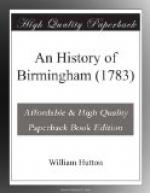Was knighted in 1325; well affected to Edward the Second, for whose service he raised four hundred foot. Time seems to have put a period to the family of Someri, Lords of Dudley, as well as to those of their predecessors, the Paganalls, and the Fitz-Ausculfs.
In 1327, the first of Edward the Third, Sir William was summoned to Parliament, by the title of William Lord Birmingham, but not after.
It was not the fashion of that day to fill the House of Peers by patent. The greater Barons held a local title from their Baronies; the possessor of one of these, claimed a seat among the Lords.
I think, they are now all extinct, except Arundel, the property of the Norfolk family, and whoever is proprietor of Arundel castle, is Earl thereof by ancient prescription.
The lesser Barons were called up to the House by writ, which did not confer an hereditary title. Of this class was the Lord of Birmingham.
Hugh Spencer, the favourite of the weak Edward the Second, had procured the custody of Dudley-castle, with all its appendages, for his friend William, Lord Birmingham.
Thus the family who had travelled from Birmingham to Dudley every three weeks, to perform humble suit at the Lord’s court, held that very court by royal appointment, to receive the fealty of others.
By the patent which constituted William keeper of Dudley-castle, he was obliged to account for the annual profits arising from that vast estate into the King’s exchequer. When, therefore, in 1334, he delivered in his accounts, the Barons refused to admit them, because the money was defective. But he had interest enough with the crown to cause a mandamus to be issued, commanding the Barons to admit them.
SIR FOUK DE BIRMINGHAM,
1340.
This man advanced to Sir Baldwin Freville, Lord of Tamworth, forty eight marks, upon mortgage of five mills. The ancient coat of the bend lozenge, was now changed for the partie per pale, indented, or, and gules.
In 1352, and 1362 he was returned a member for the county of Warwick; also, in three or four succeeding Parliaments.
SIR JOHN DE BIRMINGHAM,
1376.
Served the office of Sheriff for the county of Warwick, in 1379, and was successively returned to serve in Parliament for the counties of Warwick, Bedford, and Buckingham. He married the daughter of William de la Planch, by whom he had no issue. She afterwards married the Lord Clinton, retained the manor of Birmingham as her dower, and lived to the year 1424.
It does not appear in this illustrious family, that the regular line of descent, from father to son, was ever broken, from the time of the Saxons, ’till 1390. This Sir John left a brother, Sir Thomas de Birmingham, heir at law, who enjoyed the bulk of his brother’s fortune; but was not to possess the manor of Birmingham ’till the widow’s death, which not happening ’till after his own, he never enjoyed it.




